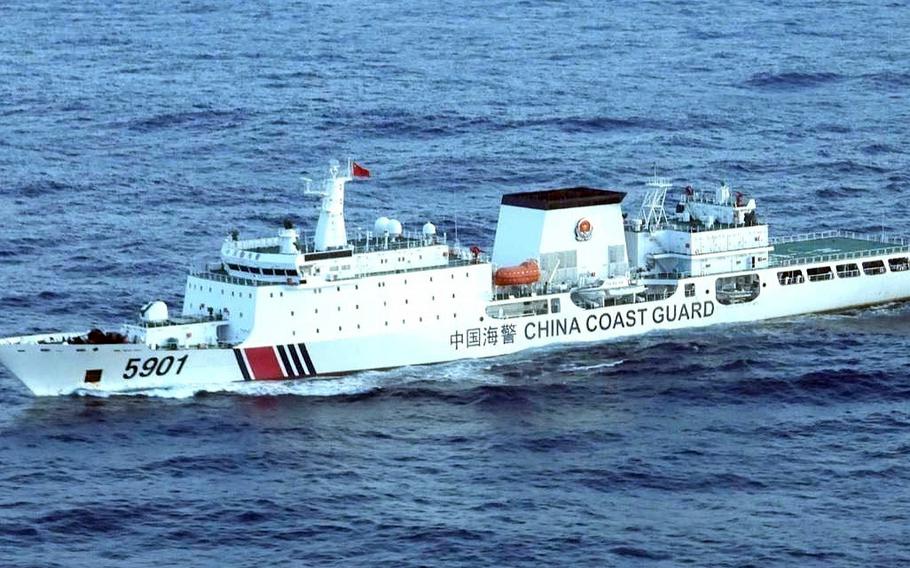
The Chinese coast guard cutter CCG-5901 sails near Luzon, Philippines, Jan. 4, 2025. (Philippine coast guard)
The United States should provide its ally the Philippines with the type of sound cannons the Chinese coast guard employs to harass Philippine vessels, according to an expert on international relations in the Indo-Pacific.
China’s coast guard recently deployed a sound cannon, able to blast noise loud enough to cause pain and damage hearing, as part of a harassment campaign targeting Philippine vessels in disputed South China Sea waters.
The long-range acoustic device was used Jan. 25 against a Philippine coast guard vessel, according to Philippine navy and coast guard officials quoted by Philippine media.
The nation’s coast guard did not reply to questions emailed Monday about the incident.
However, Patricio Abinales, a professor at the University of Hawaii’s School of Pacific and Asian Studies, recommended the U.S. provide the Philippines with its own sound cannons to deter Chinese vessels pushing deeper and deeper into the country’s territorial waters.
“This is a game of brinksmanship now,” he said by email Monday.
Sound cannons are relatively inexpensive, according to Arizona State University engineering professor Braden Allenby.
“Over 25 navies around the world currently deploy such devices, and civilian ships may use them to discourage piracy,” he said in an email Tuesday.
Police in the U.S. and elsewhere have such devices, Allenby added.
“Whether to deploy them in a confrontation with an aggressive Chinese force is, of course, another matter entirely,” he said.
The Chinese could respond with an array of nonlethal, gray-zone tactics, including irritating gases and chemicals, energy devices, tasers and rubber bullets, Allenby added. Cyber sabotage and disinformation campaigns are also possible, he said.
“Moreover, given the behavior of their Russian allies, sabotage of undersea and terrestrial infrastructures, and even assassination, cannot be ruled out,” he said. “It would be wise to assume that the Chinese will potentially use whatever they think they can get away with, without triggering a kinetic response by the United States.”
The sound cannon incident occurred near Capones Island, just off the coast of the Philippines’ main island of Luzon and about 20 miles from Subic Bay, once home to America’s largest overseas naval base, the Philippine Daily Inquirer reported Jan. 27.
The device was apparently used to deter the Philippine coast guard vessel BRP Cabra from approaching a Chinese ship, a Philippine coast guard spokesman told reporters after the incident, according to the newspaper.
China had moored the 12,000-ton CCG 5901, the world’s largest coast guard vessel, off the island while smaller Chinese vessels moved closer to the coast, said Commodore Jay Tarriela.
The Chinese “monster ship” retreated that day to 90 miles from the Zambales coast following hourly radio challenges from the BRP Cabra, he said.
The use of the sound cannon reflects “an increase in the aggression of the Chinese Communist Party in the West Philippine Sea,” Philippine navy spokesman Rear Adm. Roy Trinidad told reporters Tuesday, according to a report on the Philippine Star the next day.
The West Philippine Sea, according to Philippine authorities, refers to parts of the South China Sea within the Philippines exclusive economic zone.
Beijing has reclaimed land and built military facilities in disputed South China Sea territory. Its claims are challenged by neighboring countries, including Brunei, Malaysia and Vietnam.
China has employed so-called gray zone tactics that fall short of warfare against the Philippines in disputed waters.
For example, the Philippines has accused China of ramming its vessels, pointing lasers at crew and buzzing fishermen with helicopters.
In December, diplomats from the U.S., the Philippines and Japan met in Tokyo and reiterated their expectation that Beijing comply with a 2016 international court ruling against its claim to virtually the entire South China Sea.